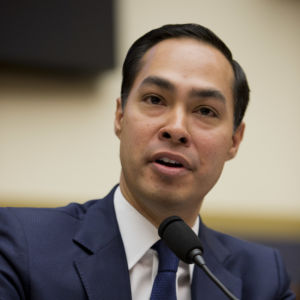The United States is failing to seriously address lead poisoning in its low-income communities, a severe public health threat touching more than 535,000 children a year, Housing and Urban Development Secretary Julián Castro said Wednesday.
Speaking at the Center for American Progress think tank in Washington, the former Democratic mayor of San Antonio was one of several experts lamenting that the issue isn’t more of a national priority.
“If there’s one challenge it’s competing priorities,” he said. “There are so many needs out there, whether it’s at the local level, the state level or the federal level. There are significant resources that go into remediating these hazards, but not nearly enough to get the job fully done.”
Castro spoke, as the think tank noted, since “national outrage around Flint, Michigan’s water crisis has increased attention on the critical issue.” Yet he focused on the more prominent threat of lead paint in homes, describing it as “one of the biggest challenges” with the poison, and touting new action from his department to address it.
Last month, Castro announced an initiative called the Lead-Safe Homes, Lead-Free Kids Toolkit. It aims to better identify and control lead hazards at HUD-supported homes by, among other things, aligning the department with Centers for Disease Control lead standards; working with other federal agencies; and providing residents with more social services to respond to poisoning.
The secretary also said increased congressional funding is required to meet this challenge.
“I think, for a lot of folks, it’s not seen as sexy,” Minneapolis Mayor Betsy Hodges said of the lead poisoning issue, speaking alongside Castro. But the Democrat said it relates directly to the problem of youth violence, which can be common in cities like hers: “Some of the violent activity we see among young people in their later teens and early twenties — you can trace back to exposure to lead.”
Another speaker, Green & Healthy Homes Initiative president Ruth Ann Norton, called for a national summit on the issue before the next presidential administration arrives in Washington.
The District of Columbia itself is grappling with lead contamination this year, primarily related to water, as in Flint.
In March, a Flint whistleblower told InsideSources that D.C.’s lead water crisis between 2000 and 2004 would have a long-term health impact “20-30 times worse” than what happened in Michigan.
Notably, he also voiced lingering concerns about lead pipes remaining in the system in 2016.
DC Water then revealed that the city still has thousands of lead pipes, but said tap water has for years met all federal Lead and Copper Rule safety standards at the Environmental Protection Agency.
The water authority did allow that lead “can still enter drinking water that travels through a lead service pipe, lead solder or household plumbing containing lead,” as General Manager George Hawkins wrote in a letter to Eleanor Holmes Norton, the District’s delegate in the House of Representatives.
That writing turned out to be prescient.
After more tests, elevated lead levels were found in water at multiple District schools and libraries, and D.C. officials moved to heighten local safety standards.
This was before lead levels were discovered too high in a congressional office building.
Overall, DC Water still stresses that District lead levels are historically low, but notes that “every property is unique and we want our customers to have easy access to all of the available information.”
To that end, the authority published a comprehensive map of the city’s lead pipes, much to the delight of public data enthusiasts.
Vox called the move “remarkable,” reporting that data “shows that at least 12,000 buildings (primarily private residences), rely on public lead pipes for water service.”
Adding perspective, the website noted that most District homes didn’t test positive for lead in their water, “lead pipes are not a significant percentage of D.C. water mains” and not all homes with lead pipes are at risk.

